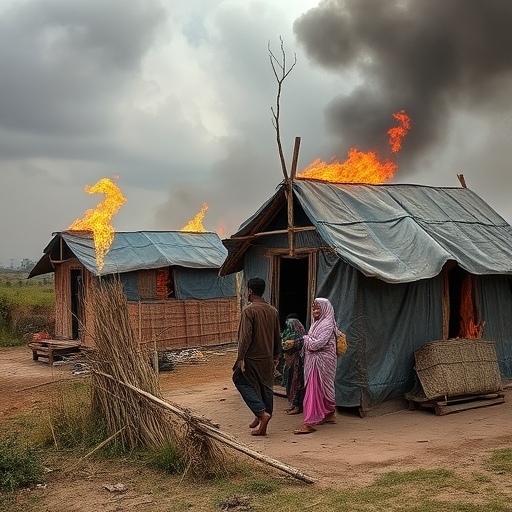S. M. Muhibullah
In the early hours of dawn in August 2017, thick clouds of smoke filled the air of the villages in Myanmar’s Rakhine State as their house were in flame. The “Rohingya”, a predominantly Muslim minority, fled their homes while many leaving with nothing more than the clothes they were wearing. Driven by fear, many people crossed rivers, trekked through dense forests without food or water for days only to escaping the violence that had devoured their lives. Their destination was uncertain and a large number of Rohingya choose to escape in Bangladesh. Whatever location they chose, one thing was certain. A life of displacement was waiting for them where survival was their only immediate concern.
When Rohingya families began to arrive in Bangladesh’s Cox’s Bazar, the sight was overwhelming. Empty fields were transformed into settlements of refugee tents made from bamboo and tarpaulin. Hundreds of thousands of refugees poured into these camps who were not only exhausted and traumatized but also in desperate need of basic necessities. It became the largest refugee settlement in the world. Humanitarian aid organizations rushed to Cox’s Bazar to provide emergency assistances. Thus, necessities like food, water, shelter, and medical care were top priorities. For the Rohingyas survival was a daily battle. The overcrowded conditions led to spread of disease while many were struggling to make sense of their new reality. There was no time to process the emotional scars left by the violence they had fled.
As a result, a different kind of suffering emerged by the passage of time. The visible wounds had been treated, but invisible ones like trauma, anxiety, and grief remained. The Rohingyas had lost more than just their homes; they had lost family members, their communities, and their sense of security. Insecurity and horrifying experiences back in Myanmar were engulfing their life daily.
Firstly, the focus in the camps remained on physical survival by ensuring minimum basic needs. However, longer the refugees stayed in these temporary shelters, another urgent need was surfacing. Many Rohingya began showing signs of psychological distress, including sleeplessness, flashbacks, and deep sadness. Children, once full of life, became trapped into a confined area in another country. Adults of different wealth class and social status back in Myanmar were living into same refugee camps just to live another day. Depression, trauma and anxiety prevailed into their life. In that situation, addressing this unseen wound became also a vibrant need of the Rohingya community.
It wasn’t long before humanitarian organizations recognized the need for Mental Health and Psychosocial Support (MHPSS) in the camps. Besides interventions like Food, WASH, Site Development, Health, and Education, MHPSS was also a urging need. Slowly the focus began to shift from mere survival to healing their unseen wounds too. The International Organization for Migration (IOM), UNHCR, UNFPA and other agencies stepped in for providing MHPSS services. At first, providing this service was very challenging as mental health was a topic surrounded by stigma within the Rohingya community. Additionally, availing an intangible service was a new concept to them as all other services in camp were tangible to be mentioned in broad sense. However, over time as trust grew people began to seek help. Slowly, the camps saw a transformation. Safe spaces were created for children to play, draw, and express themselves—often for the first time since their displacement. These programs gave them a glimmer of hope and normalcy.
For the Rohingya, healing was not just an individual process rather it was a community effort. Religious leaders, respected figures in the camps like Block Majhee, community volunteers were engaged in the MHPSS programs to reduce the stigma surrounding mental health issues. Community based support groups emerged where refugees could share their stories, comfort one another, and find comfort in shared experiences. Extreme cases were reported to trained counselor or psychologist so that they can be treated with counselling, medication whatever were needed. The programs were not only about addressing personal trauma but also about empowering individuals to rebuild their lives. Women who had suffered immense trauma found strength in women only spaces, where they could speak freely about their experiences, learn coping strategies, and gain new skills. MHPSS services started in s small scale, with group therapy sessions and counseling programs that allowed refugees to speak about their trauma in a safe environment. Trained counselors, many of whom were Rohingya themselves, facilitated these sessions using culturally sensitive approaches. They were called Lay Counselor in camps. Culturally appropriate ceremonial events also took place to keep them jolly. Children were given educational and recreational activities, helping them recover their lost childhoods. MHPSS services allowed the Rohingya to look toward the future with a renewed sense of purpose and hope. Slowly, they began to heal the emotional wounds that had once seemed too deep to ever mend.
Despite these significant efforts, challenges remain. First of them is that the Rohingya community’s future is uncertain. They are still stateless, living in temporary shelters, and still hoping for a lasting solution. The adolescents who came in the camps in 2017, has now become adult. They are still finding their purpose of life beyond survival. However, through MHPSS services they are building resilience. By addressing both their mental and physical needs, the Rohingya have begun a journey toward healing.
The story which started as a journey of survival has now shifting to a one of strength and hope. Their journey is not over yet but the sufferings and turmoil that they have endured throughout the recent years is a testament to their resilience. This journey from survival to receiving mental health support depicts a powerful picture of human resilience in the face of adversity. The Rohingya community is a reminder of the importance of healing not only the body but also the mind.

